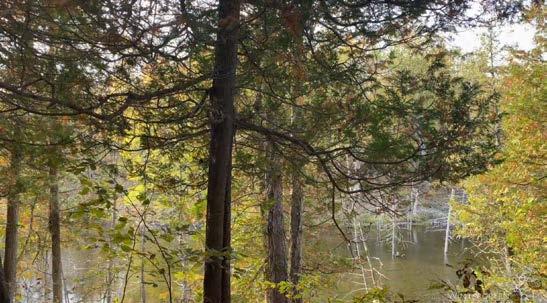
6 minute read
Hot Tea on a Cold Day
By Monica Capovilla, Executive Director, Wintergreen Studios, Limestone Chapter
Editor’s Note: The OWA thanks our friends at Wintergreen Studios for contributions to this issue of The Ontario Woodlander. Located in the Township of South Frontenac, Wintergreen Studios is a non-profit offering educational programming for sustainable living, with a focus on the arts, and also provides meeting facilities for individuals and groups, including wilderness weekend retreats. Their lodge, cabins and land are in the Frontenac Arch Biosphere Reserve in Southeastern Ontario. For more information: https://www.wintergreenstudios.com/
Advertisement
Sit back, close your eyes, and come with me on an adventure. It is a brisk winter’s day in early February, about -15ºC. The sun is peeking out just beyond the treetops for the first time in what feels like forever. You pull on your bibbed snow pants and zip your down coat up to your chin. You pull your fluffy wool hat over your ears and lace up your tall, sheepskin-lined boots. You excitedly step outside and take in a deep breath of the crisp morning air. You strap on your well-loved snowshoes, extend your poles, slip on your knit mittens, and energetically set off down the Main Trail at Wintergreen Studios toward Paddy’s Lake. You pass by the labyrinth, covered in a fresh blanket of snow from the night before, barely able to make out the stone-lined paths. You nod at the Meadow Hut, its shrubs nestled on the living roof greeting you as you pass by. You make your way through the cluster of birch trees, up to the top of the hill where you see a pair of deer, munching on some twigs. You look out over Long Pond—it somehow feels as though you can see the whole world from there. You make your way down the steep hill, one rock at a time, conveniently placed as if to have created a set of stairs. You reach the short wooden bridge only to be coaxed up the other side by the sound of blue jays off in the distance. You reach Long Pond Island, admiring the tracks in the snow and the patches of cattail in the distance, but you are called forward by the earthy smell and sound of moving water. You find yourself walking across the bridge where you notice a beautiful beaver dam—the trees arranged like a piece of art. You continue walking, taking a moment to play a tune on the xylophone that is thoughtfully strung between the trees, only to realize that you have found yourself in the mystical Cedar Forest. Its cascading boulders and towering trees with gnarled branches tell stories of all the animals that call it home. You take a few minutes to admire the scene, committing it to memory for times to come, and continue the steep trek up the hill, grasping the ropes as you put one foot in front of the other.
After a few hours exploring the trails and taking in the sights—having visited the woodland cabins along the way—you return to the Lodge. Its yellow
Cedar trees on Long Pond Island
strawbale walls greet you like a warm embrace. You stoke the wood stove, take off a few layers, fill the kettle with fresh well water, and set it on top. Soon the steam begins to rise, and the sound of a train whistle fills the air. You pull the Eastern Cedar cuttings that you collected from your pocket, grab a tea pot, and submerge them beneath the boiling water. After a few minutes of steeping, you pour the golden elixir into a delicate antique teacup balanced on its saucer. You take a few sips of tea and bask in the sunlight streaming in from the clerestory windows high above you. “A true winter adventure,” you think to yourself. “What a true feeling of connection to the natural world and a deep appreciation for all that it has to offer.” While this magical winter adventure may sound like a fairy tale, there is good news: that comforting pot of Cedar Tea can easily be recreated in your own home! We recommend using cuttings from Eastern White Cedar (Thuja occidentalis), also known as northern white cedar or swamp cedar, as it is native to Eastern Canada and much of the North Central and North Eastern regions of the United States, and quite common. Look for cedars near streams or ponds as they tend to favour cool, moist, nutrient-rich locations.
Cedar tea truly is a golden elixir and has long been touted for its medicinal benefits. In many Indigenous cultures, cedar branches are used in sweat lodge ceremonies, to purify homes, and as a medicine as the tea of simmered cuttings is used to treat fevers and rheumatic complaints, chest colds, and flu. The cedar’s volatile oil helps the body release excess mucous from
the respiratory system and because it is also extremely high in vitamin C, cedar tea has long been used to treat chest colds. Cedar is also high in proanthocyanins, which are considered to be important for helping prevent cancer, as well as resveratrol, an antioxidant associated with anti-aging and cardiovascular health. Talk about a cure-all!


Cedar tea ready to drink
While cedar tea typically has a pleasantly sweet and earthy flavour, it can sometimes be bitter or overly potent, so another plant which can be harvested to make tea even in the dead of winter is sumac. Staghorn Sumac (Rhus typhina), also known as velvet sumac or stag’s horn sumac, is a species of deciduous shrub that is native to North America, the Middle East, Europe, and the Mediterranean. These hardy shrubs are drought tolerant, spread by seeds and rhizomes, and grow along the edge of woods and banks, thriving in poor soil, typically reaching between five and 15 feet in height. While exotic looking plants, it is actually the upright clusters of crimson red berries (called drupes) covered in fine hairs that gets harvested for culinary purposes, usually in Middle Eastern cuisine. Berries are dried and ground into a powder and used as a spice rub for lamb, fish, and chicken, or sprinkled on hummus to add colour and zest. For tea purposes though, the berries are kept whole. We really enjoy making Sumac Sun Tea as it is a hands-off process of extracting the lemony peppery flavour from the berries. Similar to the cold brew coffee process, the berries are removed from the stem,
Harvesting Sumac tree near Smokehouse
lightly rinsed, submerged in water, and steeped in direct sunlight for at least 30 minutes or up to three hours. The berries are then strained and the tea is ready to enjoy, though we suggest adding a touch of honey as it can sometimes be slightly bitter. This is yet another tea packed full of nutrients, as the sumac berries are high in vitamin A and C, contain antioxidants and gallic acids, boost immunity and ‘good’ cholesterol, protect cells, and regulate the gut. And best of all, the sun does all of the work!
So the next time you need a pick-me-up, we encourage you to strap on a pair of snowshoes, explore the wild, edible foods around you, and make yourself a fresh, hot cup of tea on a cold day! Some of the wild edible recipes mentioned in this article appear in our new cookbook, Cooking at Wintergreen, and others can be downloaded by visiting wintergreenstudios.com/wild-edibles. ❧

Straining the Sumac sun tea

The author Monica enjoying a glass of Sumac sun tea










